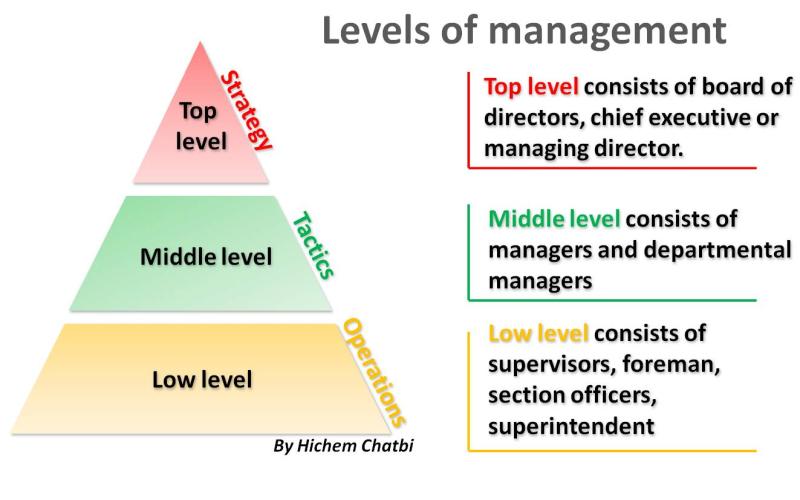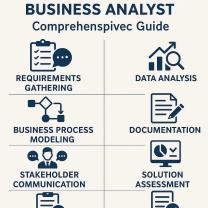What are the different levels of Management?
Management is typically organized into different levels within an organization, each with specific responsibilities and functions. The common levels of management include:
Top-Level Management:
- Also known as strategic or executive management.
- Responsibilities include setting organizational goals, defining policies, and making strategic decisions.
- Occupied by positions such as Chief Executive Officer (CEO), Chief Operating Officer (COO), Chief Financial Officer (CFO), and other top executives.
- Focus is on the long-term success and direction of the organization.
Middle-Level Management:
- Also known as tactical or operational management.
- Intermediary management level between top and lower-level management.
- Responsibilities include implementing the policies and plans developed by top-level management, coordinating different departments, and making medium-term decisions.
- Occupied by positions such as departmental managers, regional managers, and divisional managers.
First-Line or Front-Line Management:
- Also known as supervisory or operational management.
- Directly responsible for overseeing the day-to-day activities of non-managerial employees.
- Responsibilities include assigning tasks, supervising work, and ensuring that the work is in line with the organization's objectives.
- Occupied by positions such as team leaders, supervisors, and foremen.
Non-managerial Employees:
- Individuals who are not directly involved in managerial activities but contribute to the organization's operations.
- Include clerical, technical, and operational staff who carry out tasks assigned by first-line managers.
Project Management:
- In addition to the traditional hierarchical levels, project management represents a temporary and specific form of management.
- Project managers oversee projects, often working across different hierarchical levels and departments to achieve specific objectives.
Functional Management:
- In some organizations, there are functional managers who oversee specific functions (e.g., marketing, finance, human resources) across various departments.
- These managers may operate at different levels of the organizational hierarchy depending on the organization's structure.
Operational Management:
- Focuses on the day-to-day operations of a specific business unit or department.
- In industries such as manufacturing, operational managers may be responsible for production efficiency and quality control.
It's important to note that the titles and specific roles within each level can vary between organizations. Additionally, with the trend toward flatter organizational structures, some companies may have fewer hierarchical levels, while others may have additional levels depending on their size and complexity.
What are the different levels of management, and how do they function in organizations?
There are three main levels of management in most organizations:
- Top-level management: Top-level managers are responsible for setting the overall vision and strategy for the organization. They also oversee the work of middle-level and first-line managers.
- Middle-level management: Middle-level managers are responsible for implementing the plans and strategies set by top-level management. They also supervise the work of first-line managers and employees.
- First-line management: First-line managers are responsible for supervising the work of employees. They are also responsible for ensuring that employees are meeting their goals and objectives.
How do the different levels of management function in organizations?
Top-level managers typically have a broad knowledge of the organization and its industry. They use this knowledge to develop and implement long-term strategies. Middle-level managers have a more specific focus on their department or area of responsibility. They are responsible for developing and implementing short-term plans to achieve the organization's overall goals. First-line managers are responsible for the day-to-day operations of the organization. They supervise employees and ensure that they are meeting their goals.
How do organizational structures vary in terms of the number and hierarchy of management levels?
Organizational structures can vary significantly in terms of the number and hierarchy of management levels. Some organizations have a very flat structure, with few levels of management between top-level managers and employees. Other organizations have a more hierarchical structure, with many levels of management.
The number of management levels in an organization will often depend on its size and complexity. Larger and more complex organizations are more likely to have more levels of management. This is because they need more managers to oversee the different functions and departments of the organization.
Are there trends or innovations in management structures across industries?
Yes, there are a number of trends and innovations in management structures across industries. One trend is towards flatter organizational structures. This is because flatter structures can be more efficient and responsive to change. Another trend is towards the use of self-directed teams. These teams are made up of employees who are responsible for managing their own work.
Some industries are also experimenting with new forms of management, such as holocracy. Holocracy is a system of management without hierarchy or titles. Employees are organized into self-governing teams that are responsible for their own work and for setting their own goals.
Examples of innovative management structures in different industries:
- Technology: Many technology companies have flat organizational structures and use self-directed teams. This allows them to be more agile and innovative.
- Retail: Some retailers are experimenting with new forms of management, such as holocracy. This is an attempt to create a more democratic and responsive workplace.
- Manufacturing: Some manufacturers are using new technologies, such as artificial intelligence, to automate management tasks. This is helping them to reduce costs and improve efficiency.
Overall, there is a trend towards more innovative and flexible management structures across industries. This is being driven by a number of factors, including the increasing pace of change and the need for organizations to be more responsive to customer demands.













